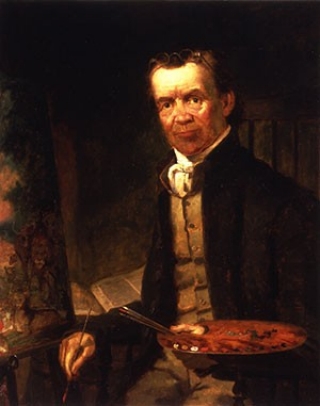Born 1780, Attleborough (now Langhorne), Pennsylvania
Died 1849, Newton, Pennsylvania
Apprenticed to Bucks County coach makers in 1793, Edward Hicks learned his trade as a decorative painter before entering the Religious Society of Friends and becoming a minister in 1811. Hicks’s talent for painting coaches and signs put him at odds with Quaker precepts favoring utilitarian simplicity. Nevertheless, he continued to undertake ornamental work to support his ministry and began making easel paintings in the 1820s to share within his community. His recognition as an artist eclipsed his considerable reputation as a preacher only after his posthumous inclusion in American Folk Art: The Art of the Common Man in America, 1750–1900, organized by Holger Cahill at MoMA in 1932. By 1938, when his work appeared in MoMA’s Masters of Popular Painting, Hicks had emerged as a major figure, identified in the catalog as “an American Rousseau.”
Hicks’s Peaceable Kingdom series, comprising more than sixty paintings, alludes to tensions within the Society of Friends that led to the Separation of 1827. The artist aligned with the Hicksite sect (no relation), which advocated an anti-authoritarian personal spirituality and quietism for its adherents. In a famous 1837 sermon, he linked ancient humoral theory with Isaiah’s prophecy about animals and children living together in peace as a way of denouncing negative traits he associated with the orthodox wing of the religion. These allusions were embodied in the animals that populated his canvases and would have been familiar to his original audience. Hicks frequently included a background scene in the paintings that depicted the 1682 peace treaty signed by the Lenape tribe and William Penn, the Quaker founder of Pennsylvania. The artist altered these elements throughout the series as his position on the religious rift evolved and his technical skills advanced, enabling him to compose larger groupings, often based on print sources. The frozen tableaux of animals that inhabit Hicks’s Peaceable Kingdom paintings incarnate the relationship between the material and spiritual worlds. Later viewers would be charmed by his celebrated visions of predator and prey lying down together.
In his later years Hicks turned increasingly to depicting landscapes and historical subjects. His sensitivity as a painter is showcased in The Cornell Farm, a canvas documenting the acreage and livestock of a prominent Bucks County property. In such late works, his growing artistic freedom is expressed in the subtle treatment of the landscape, even as he remains faithful to his lifelong dream of earthly peace and order.
Jenevive Nykolak
Mather, Eleanore Price, and Dorothy Canning Miller. Edward Hicks, His Peaceable Kingdoms and Other Paintings. New York: Cornwall Books, 1983.
Weekly, Carolyn J., with Laura Pass Barry. The Kingdoms of Edward Hicks. Williamsburg, VA: Colonial Williamsburg Foundation, with Harry N. Abrams, Inc., New York, 1999.
